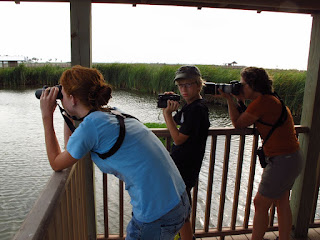In 2012, there were 233 registered Big Sit circles worldwide, most of them in the United States and Canada. But there were also circles in Panama, Sweden, Mexico, and South Africa. The braggin' rights for highest species count among all North American Big Sit circles in 2012 goes to to The No Bullsitters who were sitting at Cape May Point State Park on the southern tip of New Jersey. They had an astounding 132 species! Wow!
There were Big Sit circles in 40 of the 50 US states, begging the question of what the heck is WRONG with the 10 states with no Big Sit? [AR, HI, KS, KY, WY, TN, RI, NM, NV, MT]. A few of these have hosted Big Sits in the past so perhaps it's just a matter of not submitting their results. Here is a list of all the registered circles for 2012. And here is a link to lots of other stats for the 2012 Big Sit.
Here at Bird Watcher's Digest we love The Big Sit so much that we've been the promoters and data keepers for it since the 2002 event. Four years prior to that the good folks at Swarovski Optik became the sponsor of The Big Sit's only annual prize: The Golden Bird Prize. The Golden Bird Prize is a $500 cash award given to the winning team to apply/donate to a conservation cause/organization/project of their choice. Here's how the winning team is selected: At their annual winter meeting, the New Haven Bird Club randomly chooses a North American bird species from among all the species recorded on all the North American Big Sits. Then all the Big Sit circles that recorded that bird species are placed into a hat and one lucky team's name is drawn as the winner of The Golden Bird Prize.
The species selected for the 2012 Golden Bird Prize was the sedge wren. From among the Big Sit circles that saw a sedge wren on the 2012 Big Sit, The Wheeler National Wildlife Refuge "Wingers" lead by Dwight Cooley, were selected as the winners of The Golden Bird Prize.
 |
| The sedge wren was the species selected as The Golden Bird for the 2012 Big Sit. |
The Wingers had a very "wrenny" Big Sit, recording four wren species among their total: house, sedge, Carolina, and marsh wren. The Wingers plan to donate the $500 prize money from Swarovski Optik to the Wheeler Wildlife Refuge Association. This association, established in 1998, is an advocate for the Wheeler NWR complex and the National Wildlife Refuge Association. In addition, they sponsor and support many conservation and education projects on the refuge.
 |
| The Wingers have held a Big Sit at Wheeler NWR in Alabama for many years. |
I'm going to write about our own 2012 Big Sit here at Indigo Hill in one of my next posts and explain how we doubled our fun, if not our list of birds. Until then, stay birdy my friends.


















































